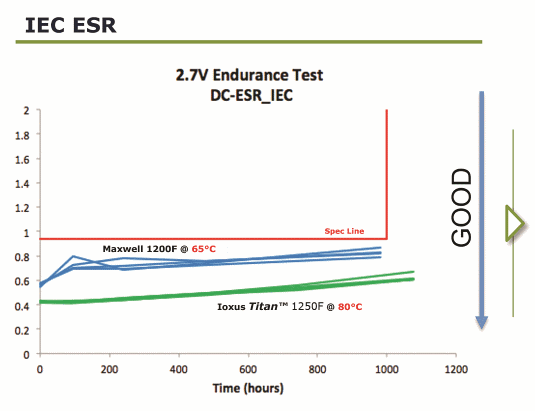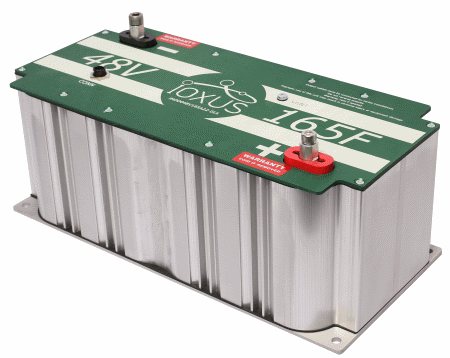BY Chad Hall, VP Marketing and Product Management,
Ioxus,
www.ioxus.com
The hybrid bus market is gaining traction worldwide as a viable means of transportation. The following questions and answers talk about what designers need to know to develop an ultracapacitor-based hybrid bus product and how to get it to market quickly.
1. Why should engineers, manufacturers, and their customers be looking at adopting ultracapacitor technology for hybrid buses?
- Hybrid buses started using ultracapacitors around 8 or 9 years ago and are quickly gaining traction. Close to 15,000 buses have been built using ultracapacitors as the sole energy storage for these buses, and the system cost has been driven down by the volume. In PHEV buses, the technology improves overall performance by alleviating the battery from many of its responsibilities. The battery provides the consistent low energy for long periods of time, such as maintaining speed, while the ultracapacitor handles all of the high current work, such as acceleration and energy recapturing during braking.. Because ultracapacitors have a very low resistance due to the lack of a chemical process during charge, the dynamic charge acceptance of a capacitor is far greater than a battery, resulting in more energy captured faster and that energy is available for use in seconds. Using a hybridized storage system allows for the strengths and weaknesses of each technology to balance out, resulting in reduced battery size, strong energy-recapture, increased driving range and extended battery life.
2. You mentioned battery life. OEMs and customers want their buses to run efficiently and operate as long as possible, no matter what ESS is being used. How much longer will an ultracapacitor based hybrid system last compared to those that are solely powered by batteries?
- A cost-effective energy storage system that is solely based on ultracapacitors typically lasts between eight to 10 years, depending on the design and the system. This life can be extended if certain sizing or design features are added to the system. Battery based systems must be significantly oversized to achieve a life of eight years, resulting in unusable energy and power, as well as a large increase in size and weight. The electrochemistry that happens inside of the capacitor or battery is what determines life. For a battery, there is a chemical reaction that takes place where the energy is stored; this chemical reaction reduces the life of the battery every time you charge or discharge it. For an ultracapacitor, there is no chemical reaction, therefore you do not quickly degrade the service life of the ultracapacitor during charge and discharge; the energy is stored electrostatically.
3. How does the ultracapacitor’s practice of regenerative braking work within hybrid buses and what are the benefits?
- Ultracapacitors charge and discharge very quickly, making them ideal for recovering energy that would otherwise be lost during the braking process. In an ultracapacitor based (energy storage system) ESS, energy created by the motor/generator from breaking is absorbed and stored in the ultracapacitor. This energy then assists in accelerating the vehicle, allowing OEMs and engineers to reduce the size of the diesel engine so that it’s only used for maintaining speed. In turn, this lessens wear on the breaks and torque on the engine.
In China, the ultracapacitor is taking on a new role of launching the vehicle. Traditionally, the battery alone will start the engine, and the engine did all of the work. New plug-in hybrid systems use both ultracapacitors and batteries are being developed and rolled out.
4. Ultracapacitors are made with lightweight materials. What's the advantage of producing lighter buses, and are the materials an advantage over batteries in terms of disposal?
- The ultracapacitor is typically 1/5th the weight of a similarly sized battery, when sized for power. If the storage system is sized for energy, the capacitor system is larger. However, most hybrid applications are really power-based systems if they are to be as efficient as possible. For example, the capacitors can capture more energy faster than a battery, allowing the bus to use the kinetic energy, capture that energy, and then launch the bus during acceleration. The added weight of a battery means additional supporting materials in the design, as well as additional safety enclosures for some batteries that have a high potential risk for fire. Using the ultracapacitor eliminates the need for the additional safety systems, reducing weight and cost, which increases the fuel efficiency and the return on investment.
Additionally, recyclability should be a top priority when purchasing any ESS. Battery-based systems have no plan for disposal, and can be very expensive and are harmful to the environment. Unlike lithium ion, ultracapacitors are 95 percent plus recyclable, as they’re made with no heavy metals. This aids to lighter buses, which helps to reduce fuel consumption and emissions, as well as the payload on the ESS. Without the need for large, cumbersome batteries, designers can fit more passengers on the bus or add other desired features.
5. Is it true, more often than not, temperature is the deciding factor in an ultracapacitor's life-span? What do designers need to know about thermal capacity and how does Ioxus' modules compare to the competitions?
- Absolutely, heat is one of the quickest ways to harm any energy storage system, however ultracapacitors work extremely well at cold temperatures. This is why Ioxus has recently developed and started branding the Titan™ technology ; the only ultracapacitor on the market that performs normally between the operating ranges of -40°C through +85°C. During this wide temperature range, the Titan product maintains the highest capacitance retention and ESR (equivalent series resistance) on the market. Batteries have a narrow temperature window, limiting their ability to perform if the temperature reaches a balmy 0°C. If it is just a starting system, ultracapacitors eliminate waiting in the cold for the engine to start and risking falling behind schedule. Hybrid buses armed with ultracapacitors will have efficient power from the start of the system even when it’s well below freezing, throughout the day.

Fig. 1a: Capacitance retention of Titan ultracapacitor

Fig. 1b: Equivalent series resistance of Titan ultracapacitor
6. What does Ioxus’ recent vibration testing exhibit about its products and the conditions that these systems are operating within?
- The hybrid bus application is very demanding mechanically and electrically with harsh conditions. That’s why we’re passionate about delivering the toughest modules available for this market segment. Our flagship hybrid bus product, the 48 Volt (V) / 165 Farad (F) modules, have undergone extremely tough durability testes and have outperformed our competitors in vibration and thermal comparisons. We also offer an eight year warranty, which is double that of most ultracapacitor manufacturers.

Fig. 2: The 48-V, 165 F module for hybrid bus applications
7. Ultracapacitor technology overall, but specifically for buses, are more widely used in Europe and Asia. Why has adoption here in the U.S. been slow?
- This is because the US government pays a very high amount of subsidies, to companies that are using high energy, high power battery banks that are very expensive, typically between $50-100k, which the subsidy pays for a large chunk of. The problem is the ROI is extremely poor – the money will never be made back.
This puts a black eye on the hybrid industry because these companies are using big powerful systems with no ROI. When it comes time to change out the batteries, they find out how expensive it is to do so and end up dehybridizing the system. In Asia, an ultracapacitor-based system costs about $25,000 with the ultracapacitor accounting for $9-12,000 of the total and is paid back within five years or so. Smaller hybrid bus systems can be paid back in as little as two years.
Another element to overcome is ensuring we have an efficient, cost-effective process in place for servicing hybrid buses with ultracapacitors. In the US, there are minimal system integrators or drive manufacturers who are producing ultracapacitor-based ESS that can also handle the necessary repairs and maintenance. They simply aren’t equipped to do both. US companies developing battery based systems are making a ton of money selling them, as well as servicing them. China’s bus companies can sell and service, because they’re big enough and better understand the technology. Without the properly trained technicians to service electric or hybrid systems, US customers will continue relying on the supplier or manufacturer, which is very expensive and few and far between.
8. What needs to be done to speed it up?
- As I alluded to in my previous answer, the US hurtles aren’t technical, they’re educational and preparedness. Other countries focus more on alternative energy systems at the university level, so their engineers have a good understanding of the technology behind electric and hybrids buses.
This lack of education into the functionality, uses, and benefits of ultracapacitor technology has created several misconceptions that are limiting the progression of ESS and the applications they serve. Though the shift away from sole battery use is taking place, a change in mindset is still needed from an engineering standpoint. We need to get more engineers to understand how an ultracapacitor, or even a battery, works and how to put them together to make the most efficient designs for the lowest costs with the highest return on investment.
9. How will the adoption of this technology for hybrid buses grow in the next decade? Will we continue to see the U.S. lag behind?
- As long as the US government offers high subsidies for battery systems, adoption of the technology here in the states will be slow. Subsidies have to be based on reality in the US, in that fuel efficiency and emissions reduction needs to be in lock-step with the system.
Hopefully by better educating designers and engineers this will open the eyes of those at the Department of Energy to the success other countries are having with these systems and the impact its having on the market – such as in China where 10,000 hybrid buses have been built this past year using ultracapacitors either in hybrid or PHEV systems.
10. What other industries do you see benefiting from ultracapacitors in the next 10 years? What are the other untapped markets?
- Outside of hybrid buses, ultracapacitors in the US are seeing good traction in other areas that require dynamic, high duty cycling such as renewable energy, rail, UPS, harbor cranes, as well as construction and heavy machinery. If I had to pick one application, I’d say automotive because the technology is ready today, with the right performance, cost, and value proposition to meet the requirements of stop/start and hybrid systems. In particular, with the Ioxus Titan technology, where the ultracapacitors can meet the temperature demands placed on under-the-hood components.
Advertisement
Learn more about Ioxus





